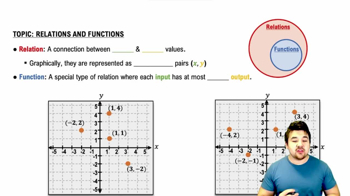Copy and complete the following table of function values. If the function is undefined at a given angle, enter “UND.” Do not use a calculator or tables.
Table of contents
- 0. Functions7h 54m
- Introduction to Functions16m
- Piecewise Functions10m
- Properties of Functions9m
- Common Functions1h 8m
- Transformations5m
- Combining Functions27m
- Exponent rules32m
- Exponential Functions28m
- Logarithmic Functions24m
- Properties of Logarithms36m
- Exponential & Logarithmic Equations35m
- Introduction to Trigonometric Functions38m
- Graphs of Trigonometric Functions44m
- Trigonometric Identities47m
- Inverse Trigonometric Functions48m
- 1. Limits and Continuity2h 2m
- 2. Intro to Derivatives1h 33m
- 3. Techniques of Differentiation3h 18m
- 4. Applications of Derivatives2h 38m
- 5. Graphical Applications of Derivatives6h 2m
- 6. Derivatives of Inverse, Exponential, & Logarithmic Functions2h 37m
- 7. Antiderivatives & Indefinite Integrals1h 26m
- 8. Definite Integrals4h 44m
- 9. Graphical Applications of Integrals2h 27m
- 10. Physics Applications of Integrals 3h 16m
- 11. Integrals of Inverse, Exponential, & Logarithmic Functions2h 31m
- 12. Techniques of Integration7h 41m
- 13. Intro to Differential Equations2h 55m
- 14. Sequences & Series5h 36m
- 15. Power Series2h 19m
- 16. Parametric Equations & Polar Coordinates7h 58m
0. Functions
Introduction to Trigonometric Functions
Problem 56a
Textbook Question
Assume that a particle’s position on the x-axis is given by
x = 3 cos t + 4 sin t,
where x is measured in feet and t is measured in seconds.
a. Find the particle’s position when t = 0, t = π/2, and t = π.
 Verified step by step guidance
Verified step by step guidance1
To find the particle's position at a specific time, substitute the given values of t into the position function x = 3 cos t + 4 sin t.
For t = 0, substitute t = 0 into the equation: x = 3 cos(0) + 4 sin(0). Recall that cos(0) = 1 and sin(0) = 0.
For t = π/2, substitute t = π/2 into the equation: x = 3 cos(π/2) + 4 sin(π/2). Recall that cos(π/2) = 0 and sin(π/2) = 1.
For t = π, substitute t = π into the equation: x = 3 cos(π) + 4 sin(π). Recall that cos(π) = -1 and sin(π) = 0.
Evaluate each expression to find the particle's position at t = 0, t = π/2, and t = π using the trigonometric values provided.
 Verified video answer for a similar problem:
Verified video answer for a similar problem:This video solution was recommended by our tutors as helpful for the problem above
Video duration:
1mPlay a video:
Was this helpful?
Key Concepts
Here are the essential concepts you must grasp in order to answer the question correctly.
Trigonometric Functions
Trigonometric functions, such as sine and cosine, are fundamental in describing periodic phenomena. In this context, they represent the particle's oscillatory motion along the x-axis. Understanding how to evaluate these functions at specific angles, like 0, π/2, and π, is crucial for determining the particle's position at given times.
Recommended video:

Introduction to Trigonometric Functions
Evaluating Trigonometric Expressions
To find the particle's position at specific times, we need to evaluate the trigonometric expression x = 3 cos t + 4 sin t. This involves substituting the given values of t into the expression and calculating the result. Familiarity with the unit circle and the values of sine and cosine at key angles is essential for this process.
Recommended video:

Introduction to Trigonometric Functions
Position Function
The position function x = 3 cos t + 4 sin t describes the particle's location on the x-axis over time. It combines the effects of two harmonic motions, each with its amplitude and phase. Understanding how to interpret and manipulate this function allows us to predict the particle's position at any given time t.
Recommended video:

Relations and Functions

 5:4m
5:4mWatch next
Master Converting between Degrees & Radians with a bite sized video explanation from Patrick
Start learningRelated Videos
Related Practice
Textbook Question
